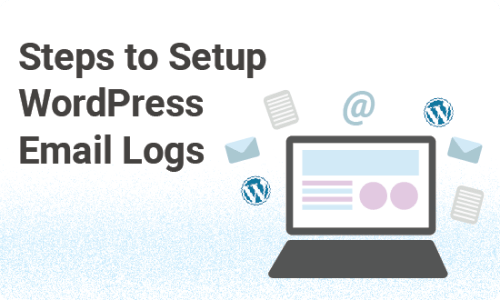One of the best things about using WordPress is how easy it is to use, and this is equally true when it comes to setting up email logs to track your visitors’ online behavior.
Of course, it’s hard to beat the ease and power you get from using a website that’s as functional and flexible as WordPress. But, in addition to being a specialist content management system (CMS) with loads of built-in features, WordPress also comes with its own powerful, easy-to-use email logs that help you track your website’s traffic.
Email logs are one of the best WordPress plugins for bloggers. Email logs help you understand your readers’ preferences on your website and make it easy to contact your Google+ connections. When you install this plugin, you can quickly identify who left comments on your blog posts and discover what they were interested in, as well as get an understanding of what they did not like so much (something you could change in the future). You can use these details to improve your communication with the people who comment on your blog posts.
Are you looking for ways to prevent spammers from impersonating legitimate email addresses? Is your schedule too busy to have to worry about putting up with spam attempts? If so, you might benefit from installing the free WP Mail SMTP plugin. This article will show you how to set up, configure, and use this plugin to check your inbox for suspicious email addresses automatically. It’s worth mentioning at this point that there are also several powerful, free tools that can help you monitor and block emails from spammers much more efficiently.
If you have ever set up an email server, whether for your personal or business address, there is a pretty good chance that you have sent at least a few emails. After all, emails are a necessary part of online life. But, in many cases, what people don’t realise is why you should turn them on and what they can do for you. In reality, there are actually several reasons to turn on email logs for WordPress: It gives you a digital log of all the emails you have received and all the links you clicked while composing your message. You can see how much time you spent on each email or which clients were the most important to you. In addition, you can see which newsletters were most beneficial and whether or not you answered each directly.
You should switch on email logs because:
- Using form notifications for WordPress is a great idea. Notifications are great for providing valuable information to your users without forcing them to open an email or solicitation in their browser. Plus, having your email marketing automation mailing list up and running can be as easy as adding one line of code to your website’s wp-config.php file.
- An email signature is one of the most valuable tools an eCommerce business has. It shows personality, communication style, and loyalty. However, some people think email signatures are just for Facebook and LinkedIn. They’re not. They communicate an idea through images and words that resonate with users. And there’s a pretty simple reason why email signatures are so essential for your WordPress website: because every single human interaction should be recorded and copied publicly as evidence of integrity in human relations. In addition, knowing who emailed whom can help with customer retention. Customers will not be interested in doing business with someone who frequently fails to update them regarding new information or who sends mixed and unclear messages.
- There are several reasons to turn on email log viewing for your WordPress website. One of the nifty things about email is that, every time you go to compose a new one, it’s saved as a draft in your inbox folder. So, when you go to reply to an email or compose a new one, you can still take a peek at the previous email in your inbox without having to refresh the entire page. This gives you an early look at what other people are saying or thinking about your content. This also makes organizing your email menu much more manageable; indeed, you can create submenus for different types of emails, allowing you to quickly switch between them without diving straight into an email that has been opened previously.
The three steps to set up WordPress email logs are:
Install
Have you ever wished that your emails went straight to your inbox instead of being delivered to a spool? If so, then the WP Mail SMTP plugin for WordPress is for you. When installed, this free plugin adds a setting that enables you to configure where your emails will be sent and configure who will have access to them. This allows you to prevent spammers from sending you junk emails and also allows you to customize your email address while keeping all your other email accounts intact.
Enable
Enable email logs in your WordPress admin panel. Emails sent to your personal Gmail address will be publicly accessible through the WordPress Logs extension. This is useful if you are a blogger who often receives complaints due to spammers trying to impersonate you. It is also helpful for checking whether a competitor’s website is also using this feature.
With this new feature, you can do exactly that. Enable Log lets you view a comprehensive history of each message you receive, including the sender and recipient information, the date and time each message was received, the subject line, and more.
When you click “Save Settings” in the bottom right corner of your browser, it enables WordPress to save your basic settings for you, so they are ready when you log into your WordPress account in the future. This means your users will be able to save specific pages or posts on your site without having to log into your localhost. Then, when they save, they’ll be able to see the changes within seconds. This feature can be extremely useful for testing changes as well as setting up backup systems for increased security.
View
There are two ways to view your WordPress email messages. The first is to visit your web host’s spam folder and view all emails sent to your domain. This can be useful if you have received several emails from the same person or have received unrequested emails from people you don’t know. The second method is to visit the spam folder of your chosen email client, such as Outlook, Gmail, and Yahoo! Mail. Once you open the email in one of these applications, you will view the date and time the email was sent and the recipient’s information (subject matter and content).
WordPress has countless powerful options for adding an email signature to your posts and pages. And, if you’re using Woo Commerce, it has the option to add an automatic email signature to all your products.
But how can you tell which settings and options are best for your site? I have put together a list of settings that you might want to check out for both existing and new signup forms on WordPress.com, as well as an example using Woo Commerce. These settings will make it easier for you and your visitors to personalize email signatures without entering everything manually. But, of course, the possibilities are endless; in fact, they’re really only limited by your imagination.



